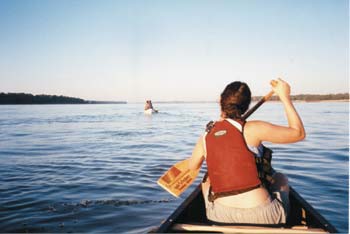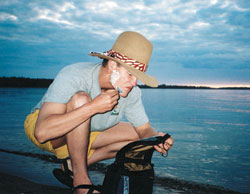
| Paddling the Mississippi to Get Voters on Board | |
| By Jane Turnis |
When nine Colorado College alumni chose to make a difference last summer, they didn’t just dip a toe in the water. They took on the entire Mississippi River – 2,332 miles of it – with canoes, paddles, sunscreen, mosquito repellant, and a cause.
Paddle for the Presidency (P4P), a nonpartisan, nonprofit effort to counter voter apathy among young people, put in at Lake Itasca, Minn., on June 1 and stopped at 11 river cities throughout the summer, rallying and registering almost 3,000 voters on their journey to New Orleans.
 The idea was hatched by Patrick Holmes ’03 after a few beers with friends in his kitchen.
The idea was hatched by Patrick Holmes ’03 after a few beers with friends in his kitchen.
“It was just a crazy idea,” Holmes said. “Then Chris Benoit ’03 put things in motion, shooting out emails to Rock the Vote and The New York Times, and we realized we’d have to become much more organized.”
They set to work. They researched other voter-registration efforts; formed a nonprofit entity; mapped out an itinerary; built a Web site, www.paddle4president.org; found coordinators to help plan rallies at each city; and obtained sponsorships from companies and organizations that provided canoes, paddles, life vests, cellular phones, and financial backing.
On June 1, they introduced themselves to a river that ranged from a mere trickle that required them to pole their way along in the mud, to a wide expanse of swiftly rushing water filled with barges and river commerce. They would encounter locks, dams, and flow-less lakes, wind, rain, lightning, mosquitoes and humidity. And they’d learn about physical and mental demands, pacing, multitasking, personalities, and commitment.
They told their own pieces of the story in “river journals” on the group’s Web site; some of those journals are excerpted here. One of the greatest challenges for the P4P canoers was juggling the physical demands of canoeing with the mental demands of organizing events, buying supplies, preparing meals, and staying on schedule.
July 29:
“On this particular day we must: A) Put as many canoes on the water as possible. B) Set up a stage and tents for an event. C) Move a pontoon boat on a trailer the size of a Radio Flyer wagon three times to make sure it is not stolen. D) Drive around reporters and volunteers to keep them happy. E) Exchange the canoe trailer for a smaller one with no working tail lights, then use that trailer to get all gear and canoers to the river to meet representatives of the press F) … Paddle fast enough or slow enough to reach the event site at exactly 4 p.m. G) Make sure everyone knows what to do upon arriving at the event. H) Buy food for the event. I). Make sure everybody is happy, girlfriends have been called, lost socks are found… and the list goes on.”
— Doug Vilsack ’03
 |
| Patrick Holmes '03 |
| Photo courtesy of Paddle for the Presidency |
Canoers wrote and distributed press releases and kept up with the news via their US Cellular-donated cell phones, which provided access to The New York Times’ coverage. Soon, the media started to take notice.
Sometimes the news coverage was lumped together with wacky voter-registration efforts across the country. Sometimes reporters canoed with the group. TV crews and radio broadcasters told their tale, and sometimes the paddlers found they already had a bit of celebrity before they arrived in a city.
July 6:
"I was belting out some classic rock ditty and doing a dance as Katie and I ravaged Sam’s Club for the week’s food. Mid-solo, I looked up and the woman handing out free Tater Tots® said, ‘I know you!’ She had seen my interview on WKBT news that morning and wow, what a crazy feeling! … Everywhere we turned in LaCrosse (Wis.), people knew who we were and what we were up to.”
— Kerri Kuhn ’03
Paddle for the Presidency news stories ran in Time, USA Today, the Minneapolis Star-Tribune, The Des Moines Register, the St. Petersburg Times, and even the Sydney (Australia) Morning Herald, among others.
The rallies, usually featuring free food and a local band, drew area political leaders as well as young potential voters. In the Quad Cities between Iowa and Illinois, Vilsack’s father, Iowa Gov. Tom Vilsack, was joined by Iowa congressional candidate Bill Gluba and Rock Island, Ill., mayor Mark Schwiebert.
The excitement of the events was interspersed with hours of paddling, sometimes in silence, sometimes in animated conversation or political debate. A day spent with a quiet paddler led to introspection. A day with a more talkative partner was helpfully distracting, sometimes amusing.
July 6:
“We spent most of the morning preoccupying ourselves from the feelings in our arm muscles with interesting and enlightening conversation. We talked politics, love, future plans, and chose what kind of dog everyone on the trip most closely resembled.”
— Katie Engelman ’04 and Jonathan Lowsley ’02
Little things helped them get through pain — or rain.
July 22:
“Pat and I… decided to both put on our headphones and listen to the same CD. The choice was obvious: ‘Creedence, baby! YEAH!’… We hit ‘play’ at the same time and ‘Suzie Q’ powered our paddles. ‘Long as I remember, the rain’s been comin’ down’ and it did. It fell from the sky almost as hard as we were paddling.”
— Arlen Ginsberg ’03
There were low points:
 |
The first event, in Minneapolis, drew few attendees. Nailing down event details from the river with coordinators on the land proved to be more difficult than expected. On top of that, it rained.
One day the group’s pontoon almost sank, with 1,500 pounds of gear on it.
It was tough, sometimes, to get several strong personalities working as a team.
“In line with CC students and the way they tend to work, we had 15 leaders and no followers,” Kuhn said. “What do you do if you have three barges and an ocean liner coming at you, and you have to figure out if you’re going to the right bank or the left bank, and all must agree? We had some heated moments.”
 |
But there were also high points:
Midway through the country at St. Louis, the effort was gaining momentum, exposure, and power, with larger crowds and more media attention. The final rally, on Aug. 21 in New Orleans, drew “750 people, four of the best bands in New Orleans, and tons of political organizations,” Kuhn said. “People would come out of the bars for a smoke break — and register to vote.”
The total number of voters registered by P4P participants: 2,956.
In all, nine Paddle for the Presidency canoers made the entire trip, and 22 — some of them journalists, some with CC connections, and some locals in each area — joined for stretches of the river.
Was it worth it?
“Oh God, yes,” Kuhn said. “Just to have the experience with your friends, to learn and grow so much, to prevail in the end — and feel like you’ve made a difference.”
July 22:
“As we sit and eat, we talk about the day and wind down. Sometimes we build a fire of driftwood and read aloud to each other. The light reflects on the faces of friends… I am surrounded by people who inspire me and encourage me to act. The result has put me in Middle America, on a river that runs through all of us, canoeing hundreds of miles in the hope of inspiring others.”
— Alaina Macauley ’04
The Colorado College | 14 East Cache La Poudre Street | Colo Sprgs, CO | 80903 || 719-389-6000